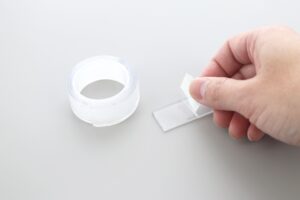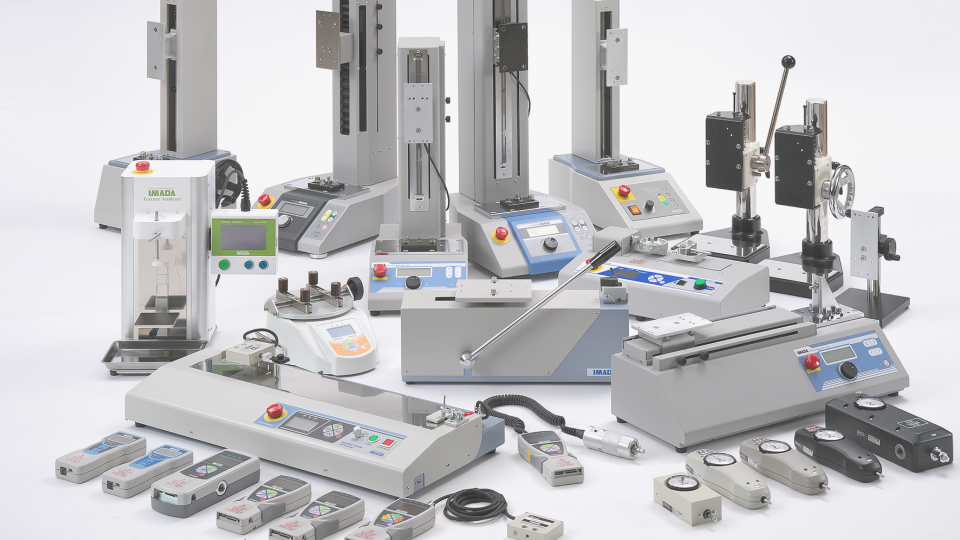Some of you, like myself, may have longed for the Spoon-Bending tricks you may have seen on TV?
In my case, it must have been around 1995.
I fondly remember my mother telling me off for attempting to bend the spoon by applying physical strength to the spoon from the kitchen. As time goes by, my Spoon-Bending admiration since then has completely disappeared. However, after so many years as an adult, recently, I had to measure a cutlery strength with the Cantilever Bending Test method at work, and my memories flushed back.
Maybe… using the force measurement method to elucidate the principle of Spoon-Bending?
There may be many perspectives and opinions, such as ” The principle of lever is…” or ”Hand power is…”, but we are the experts in measuring forces. Putting aside the fundamentals, could I figure out the tricks of how to bend a spoon by repeating force measurement procedures?

Best holding position for Spoon-Bending
Most of the Spoon-Bending seen on TV programs showed the spoons holding the handle with the bowl part facing towards the viewers, and in a matter of blink, the bowl part was bent backward with a finger. So, the first step is to investigate which part to hold for the best result, to bend with the least force application. For this measurement, I selected a force-measuring instrument with an external load sensor, the small flat sensor fitted with a white urethane cushion pad and the belt wrapped around the index finger, to pull the spoon bowl as in the image below – an excellent Force Gauge that transmits the applied forces directly.
For the best comparisons, the measuring environment must be constant. In this experiment, we moved the fixed position without changing the point of force application and measured the effect of different fixed positions on bending strength.
I used a bench vise to hold the spoon handle vertically. For comparison, I applied the maximum force needed to bend the spoon. Of course, peak values can also be obtained using a force gauge. Using the table vise, measured fixing three positions of the spoon: 1) the neck of the spoon, 2) the middle of the handle, and 3) the tip of the handle.
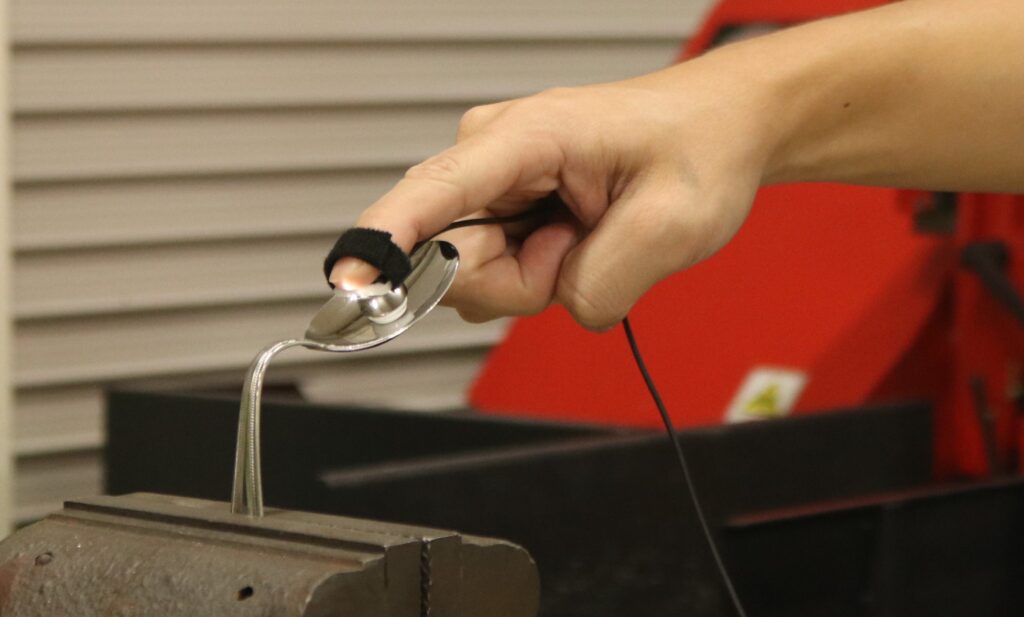

The results were (1) 40.0N, (2) 36.4N, (3) 39.1N. with differences that are much smaller than originally expected. Anyway, the spoon fixed at the center of the handle showed the result with the least force requirement for Spoon-Bending. I was surprised to have found the amount of force required and how easy it was to bend. I noticed that it is essential for the handle section to be firmly held.
Where is it best to apply the force for Spoon-Bending with little effort?
Now that the position to hold the spoon seems obvious. Next, measure which part of the bowl to apply the force. Again, using the same force gauge and the bench vise per the previous process. This time, the fixing position is unchanged. Try bending by applying forces from two different points. (1) the tip, and (2) the center of the bowl. The fixing position was set at the handle center, where the best result was obtained from the previous measurement.
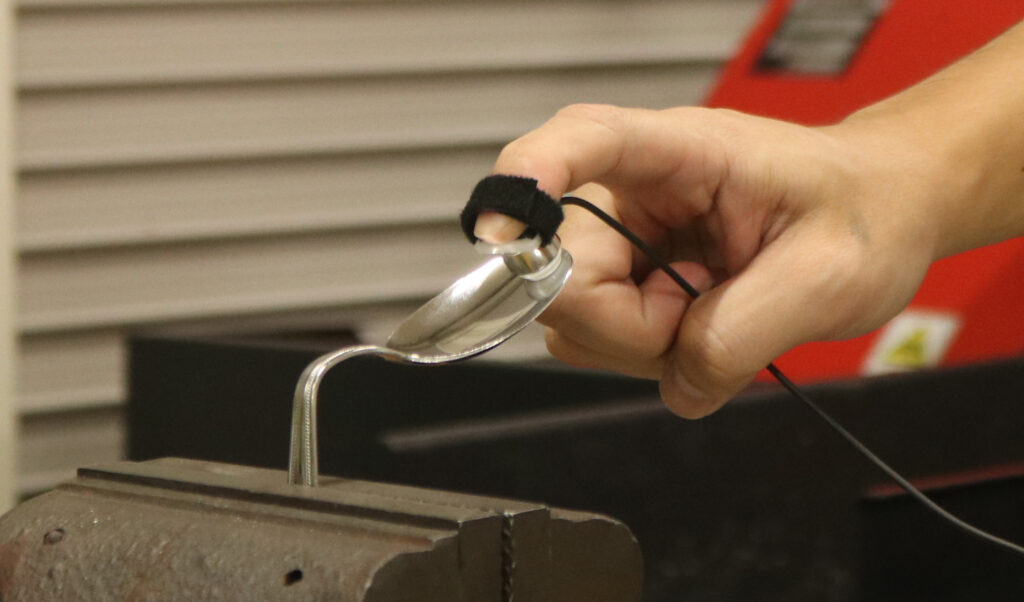
In this measurement, differences were evident. The maximum force value is (1) 27.0N and (2) 37.8N, (1) Pulling back from the tip requires much less Force to bend. I recall a case study measurement of crushing a cherry tomato with the force applied from the above. The result was about 30N, which means the Spoon-Bending force result is less than crushing a tomato!!!
Are the Spoon Handles Really Bendable?
Finally, put it into practice. The tricks from the past two measurement results are: –
to hold the center of the handle and bending pressure applied from the bowl tip.

・・・・???
More force is needed to be transmitted to the spoon to bend??? Not only that, but it is also challenging to hold the spoon steadily while trying to apply force from the tip with a finger. The fundamental function of the table vice is not replaceable with the holding strength of my fingers, unable to keep the spoon in position.
Now What? See if I can get support and advice from our technical engineers.
So・・・・My left hand done kaput, not enough power to control the spoonhandle steady?? Luck of muscle strength? The advice received was surprisingly straightforward. All I need is an additional little finger support for the very tip of the handle, and the problem solved.
I tried it skeptically, and・・・・ It works. The Mission Complete! Done!!!

The complex world of force is highly demanding. However, in my mission of finding the tricks, I also measured the aspects of the supporting fingers. Keeping the thumb in the fixed position and measuring forces of all individual fingers during Spoon-Bending measurement processes. (using the same measuring instrument as before).
Index finger: When the force exceeds 60N, I could no longer control the spoon to hold in position and gave up.
Middle finger: When the force exceeds 60N, I can no longer control the spoon to hold in position and gave up.
Ring finger: When the pressure exceeds 45N, the spoon begins to bend.
Little finger: The spoon starts to bend when it exceeds 35N.
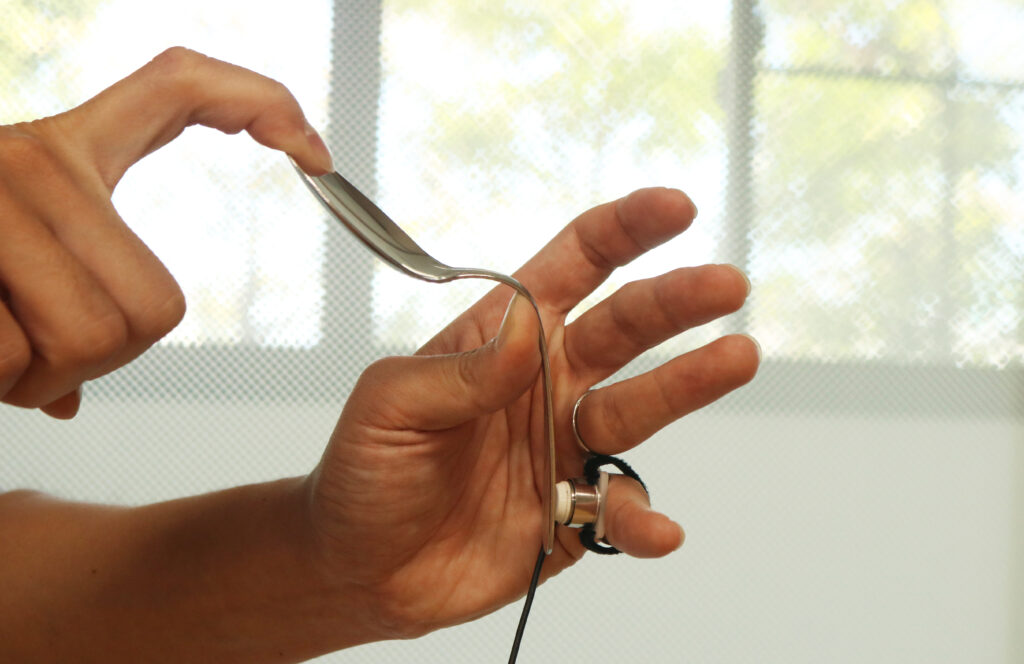
It is not that the little finger is a powerful tool, but the theory behind is that the closer it gets to the tip of the Handle (further it gets from the fulcrum), the weaker force is required to control and suppress the instability of the Spoon. Just to be sure, I also checked to see if there was any effect on the force that pulls the bowl. The result is that no difference was observed in the force value when the spoon was bent. (The principle of a lever: the further it is from the fulcrum, the smaller the force necessary, which balances the applied force to the point of force. The fundamental…)
Summary
Here is a recap of the three steps of the Spoon-Bending process: –
1. Firmly hold the spoon around the middle of the handle with the index and middle fingers and the thumb.
2. The little finger must support the handle tip. The ring finger as it is.
3. Pull to bend the tip of the spoon bowl towards your body with the other index finger.
The trick of Spoon-Bending, it seems pretty simple when you understand the know-how in simple steps. With understanding the mechanism behind the trick, it is easier to be able to come up with the result.
When bending the spoon towards your body, use index finger only; do not pinch the bowl of the spoon. No other extra pressures must be applied on the spoon when pulling to bend with fingers, as the force will not be transmitted to the handle, and as a result, the spoon will not bend (no matter how hard you try). It is also essential to use a spoon with a thin handle. Spoons with thick and heavy handles are very firm, and it is challenging to bend, even going through the correct steps (this is one of the Essenes of tricks). Were all the readers able to bend the Spoon successfully? To conclude this article with the hope that you may be experimenting with your superhuman ability, with Spoon-Bending using your spoons from the kitchen and the self-satisfied grin on your face with mission complete.
Caution: Keep these tricks hidden from your children. Refrain from revealing how simple it works. To make sure you will not run out of decent spoons. We do not repair Spoons.
Various topics related to force measurement and power are introduced on the Force Channel. Please also check other articles.
Example Video of 3-point Bending Test: 3-point Bending Strength Test of Round Bar Material
Example Video of Cantilever Bending Test: Cantilever Bending Measurement of Cutlery




